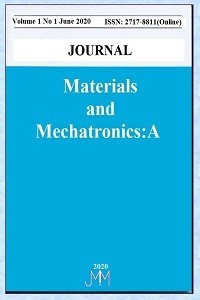Hotspot Yöntemi Kullanılarak Deneysel ve Sonlu Elemanlar Yöntemi ile Kaynaklı Bağlantı Gerilmelerinin Karşılaştırılması
Sonlu Elemanlar Metodu, Kaynaklı Bağlantılarda Gerilme, Hotspot Gerilme, Gerinim Ölçer Sensör.
Comparison of Welded Joint Stress with Experimental and Finite Element Method Using of Hotspot Method
___
- Ali D., Abbas H., Abdullah T., Numerical analysis of stress distribution during tunneling in clay stone rock. International Journal of Engineering 33(8), 1472-1478i, 2020.
- Büyükbayram C., Koç B., Tekin G., Salihoğlu B., Fatigue strength evaluation approach of welded joints for more reliable and lighter military ground vehicles. Procedia Engineering 133, 485-500, 2015.
- Dong Y., Teixeira A., Soares C.G., Fatigue reliability analysis of butt welded joints with misalignments based on hotspot stress approach. Marine Structures 65, 215-228, 2019.
- Eriksson Å., Lignell A.-M., Olsson, C., Spennare, H., Weld evaluation using FEM: a guide to fatigue-loaded structures. Industrilitteratur 2003.
- Feng R., Tang C., Roy K., Chen Z., Chen B, Lim, J. B., An experimental study on stress concentration factors of stainless steel hybrid tubular K-joints. Thin-Walled Structures 157, 107064, 2020.
- Güven F., Rende H., An analysis of endurance limit-modifying factors depending on bead shape and thickness in load-carrying welded T-joints. Journal of the Brazilian Society of Mechanical Sciences and Engineering 42(2), 1-8, 2020.
- Hobbacher A., Recommendations for fatigue design of welded joints and components (Vol. 47). Springer, 2016.
- Iqbal N., Fang H., Naseem A., Kashif M., De Backer H., A numerical evaluation of structural hot-spot stress methods in rib-to-deck joint of orthotropic steel deck. Applied Sciences 10(19), 6924, 2020.
- Kim Y., Oh J.-S., Jeon S.-H., Novel hot spot stress calculations for welded joints using 3D solid finite elements. Marine Structures 44, 1-18, 2015.
- Li S., Ren S., Zhang Y., Deng D., Murakawa H., Numerical investigation of formation mechanism of welding residual stress in P92 steel multi-pass joints. Journal of Materials Processing Technology 244, 240-252, 2017.
- Meyghani B., Awang M., Wu C., Thermal analysis of friction stir welding with a complex curved welding seam. International Journal of Engineering 32(10), 1480-1484, 2019.
- Niemi E., Fricke W., Maddox S. J., The structural hot-spot stress approach to fatigue analysis. In Structural Hot-Spot Stress Approach to Fatigue Analysis of Welded Components (pp. 5-12). Springer, 2018.
- Schroepfer D., Kromm A., Kannengiesser T., Improving welding stresses by filler metal and heat control selection in component-related butt joints of high-strength steel. Welding in the World 59(3), 455-464, 2015.
- Shin W., Chang K.-H., Muzaffer S., Fatigue analysis of cruciform welded joint with weld penetration defects. Engineering Failure Analysis 120, 105111, 2021.
- Yamamoto N., Sugimoto T., Ishibashi, K., Tanaka, S., A study on the type-b hot spot stress. Welding in the World 64(11), 1833-1842, 2020.
- Yayın Aralığı: Yılda 2 Sayı
- Başlangıç: 2020
- Yayıncı: Yusuf KAYALI
Pomza Taşının Otomotiv Sürtünme Malzemesi Olarak Kullanımının Araştırılması
Emin ÇENGELCİ, Hüseyin BAYRAKÇEKEN
Sonlu Ufukta Genelleştirilmiş Kesinlik Eşdeğerlerinin Optimizasyonu
Derviş ÖZKAN, Garip ERDOĞAN, Yasin OZGURLUK, Gülfem BİNAL, Sefa Erdem YILMAZ, Abdullah KARAOGLANLİ
Mikro-Frezeleme Yöntemi ile İşlenen İnce Duvarlı Yapılarda Deformasyonun İncelenmesi
Ahmet HASÇELİK, Kubilay ASLANTAS
Elle Kaldırma Hareketinde Kutu Boyutunun L5/S1 Eklemine Etkisinin İncelenmesi
Melih CANLIDİNÇ, Mustafa GÜLEŞEN
Zekerya KAYA, Bekir AKSOY, Koray ÖZSOY
